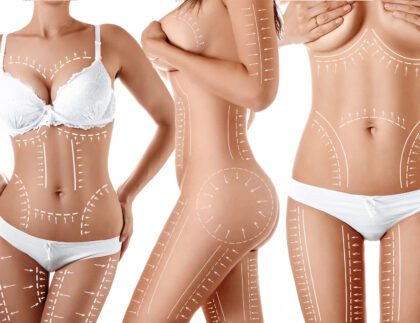
Post-Surgery Recovery Myths Debunked
There’s so much information on the internet about what to expect post surgery, what you should be doing, all the crazy things you need to buy, and a lot of it is actually incorrect. To help set the record straight, our plastic surgery recovery specialist at Amare Healing Arts shares the most common post-surgery myths and the scientific reasons for their myths. Read on to learn what to actually expect post-surgery and what you need to be doing to heal properly.
Myth: Your Post-Op Massages Should Be Painful
We get clients calling all the time with the same burning questions: Do post-op lymphatic massages hurt? Do I need to take a painkiller before my session? Is it going to hurt like I see on social media?
NO! This is definitely not true! The type of massages you should be getting right after surgery are called manual lymphatic drainage massages, which consist of gently working with the skin in a specific sequence that stimulates your lymphatic system. This helps move lymph (excess swelling after surgery) from where it's trapped under the skin, back into the body by being reabsorbed by your lymphatic system so it can be processed out through your urine. That's how the body is designed to work. Every single day, your lymphatic system is reabsorbing swelling and fluid, and you're peeing it out!
All we're doing during these massages is working with the system that's already there, boosting it and speeding up the absorption rate so we can get your swelling down faster and prevent fibrosis.
It’s a MANUAL dilation of the LYMPHATIC vessels to get them to speed up and increase the DRAINAGE of any excess fluid and swelling in your body, which your system does already all the time.
These massages do not hurt, are not painful, and should actually feel really good. They are super gentle because the lymph vessels are only a hair thick and are located a hair deep beneath your skin. If your massages are deep and painful, we’re missing these vessels entirely, causing more swelling and tissue damage, just pushing fluid around in the tissue, without ever getting it back into the lymphatic system to be absorbed.
Myth: Fibrosis Always Happens After Surgery
This is a myth. Fibrosis can happen after surgery, but it’s not something that’s part of the normal healing process. Well then, how does fibrosis happen after surgery?
Fibrosis is a congealed, thick form of swelling that your body can't absorb.
The swelling after surgery gets stuck, stagnant, begins clumping up and hardening, which can eventually become permanent tissue if not dealt with. Swellings job is to make new tissue, and there are many reasons that could cause your swelling to thicken and harden, like using machines after surgery or a garment that's 3 sizes too tight, but it's meant to stay as liquid as possible. You can turn it back to liquid swelling using our Lipo Foams that are designed to stimulate your lymphatic system in your garment, keeping your swelling as watery as possible for your lymph system to pick up and your body to urinate out.
Myth: Incisional Drainage or Squeeze Massage Helps Drain Excess Fluid From the Body
First off, this incisional drainage or “squeeze massage” is NOT legal for massage therapists to do in several states. It directly violates their massage license. You shouldn't be getting incisal drainage. Second, it actually causes fibrosis by trapping your swelling and compacting it in the tissue that's trying to heal. The constant pushing of swelling towards your incision sites causes a thick compacted mass of swelling that settles and becomes hard fibrosis. Swelling isn't designed to leave the body that way. When you stub your toe and it's swollen, you don't cut it open and try to push the swelling out of it. The fluid you see pouring out of people post-op on social media is blood and bodily fluid and that's not how the body processes swelling, as we just learned in the previous myth.
Remember, right after surgery, your tissue is still healing and is very fragile. Gentle manual lymphatic drainage massage is what you should be getting done to reabsorb swelling so you can then pee it out the way it's designed to.
Also, no one other than a licensed medical professional should be using needles on you, pulling your drains out, handling incision and stitches or aspirating you (pulling fluid out of your body with a syringe).
Myth: You Can Use Any Faja From Amazon and Other Random Post-Op Supplies You Find on Social Medial To Get Rid Of Swelling After Surgery
You need to make sure that the type of compression garments or commonly called “fajas” you’re buying are medical grade, fit appropriately, and are designed to help reduce swelling.
The word Faja is Spanish, which means girdle. This isn't a compression garment meant for post-op. Are they used for post-op? Yes. Are they too tight and cut into your tissue? Yes. Are there a million of them on Amazon and it's almost impossible to find the right size and fit for your surgery? Also, yes.
Just because you see people using things like rollers, machines, waist trainers, random fajas and everything else under the sun online for post-op, doesn’t mean they are supposed to be used or appropriate for helping your body recover after surgery.
When you’re looking into garments and supplies, make sure you're getting things that are used for medical surgeries, you understand how to use them, when to use them, why to use them and how they work. You don’t need a million stage garments, you don’t need 10 different lipo rollers, you need someone who can understand your swelling specific to your surgery, that can recommend medical grade products and teach you how to use them. Plastic Surgery is still surgery. It’s still a medical procedure, and the basic supplies and compression you need is the same as if you had a knee surgery or any other medical surgery.
You can purchase medical grade post-op supplies from us online if you’re looking for a trusted source.
Myth: You Should Use a Heating Pad on Your Body Post Surgery
There’s a fancy word called vasodilation. Which is normally, a function that exists in the body to assist in healing and inflammation by increasing blood flow to damaged cells and tissue. So then does heat help with healing after surgery? Nope, it's actually the opposite.
You don’t want to artificially or externally increase inflammation during a time when you’re already having excess swelling issues and heat can do that. Yes, heat may feel good on sore muscles, but it's the tissue we're worried about. Think about this. If you burn your hand and it’s already swollen, we wouldn't put a heating pad on it. Although you may be weeks post-op and your tissue may not be hot or inflamed, you still have swelling and heat is going to increase that swelling.
Myth: You Need Tight Compression Garments to “Get Snatched” and Get Rid of The Swelling.
The role of a compression garment is to close the tissue space where the surgery was done so it doesn’t heal with swelling in it and support the tissue while it's healing. Garments aren't meant to move your swelling. Actually, a garment that is too tight can compact your swelling creating fibrosis and cut into you, causing more swelling.
Having 2 people try and squeeze you into the tightest garment possible, laying on the bed, holding in your stomach and trying to close the garment isn't the answer to your swelling problems. Your garment should fit like a soft cast. You should be able to move and breathe. The garment's job is to hold you, not make you snatched. The thing that gets rid of swelling to make you snatched is manual lymphatic drainage massage.
Myth: You Should Use Rollers Post Surgery to Reduce Swelling
And finally, everyone's favorite questions because they see it all over social media: Can you use rollers after surgery/can you use rollers after lipo?
Rolling does nothing to help with swelling; it's meant to loosen up muscles, and with surgery, it's all about tissue healing, not muscles.
The only way your body gets rid of swelling is by reabsorbing it into your lymphatic system. We know that MLD is very gentle because the vessels are so tiny and superficial. We know that the massage is a specific skin stretching movement in a certain sequence, following the lymphatic mapping of the body, triggering you to pee out the swelling. A roller is not going to dilate those vessels or get rid of your swelling, it's used for sore muscles.
The thought behind rollers post-op is that we can “break up the fibrosis” or we can “smooth out the swelling”, but scientifically, that's just not how the body works.
You can actually do more harm to your body if you do this right after surgery. If you’re using a roller and being aggressive or deep, you're going to cause more swelling and even turn that swelling into fibrosis.
Manual lymphatic drainage massage helps reduce swelling by stimulating your lymphatic system. Rolling won’t do this.
Everyone loves to share their surgery journey, the tips, tricks and hacks they used for surgery but they could be doing more harm than good. Healing from plastic surgery should be handled like healing from any other medical procedure. A good rule of thumb next time you hear a hack or tip for recovery, just think, if I stubbed my toe and had swelling, how would I take care of it? Would I do the kind of post-op lymphatic massages that hurt and try to squeeze the fluid out of it? If you had a joint replacement, skin graft, or any other medical procedure, can you use rollers after surgery to get rid of the swelling? Plastic Surgery is still surgery and needs to be treated with the same care as any other medical procedure! Happy Healing!
To learn more about post-surgery recovery, check out our online course, which goes over everything you need to know about manual lymphatic drainage and healing post surgery from us here at Amare Healing Arts.



